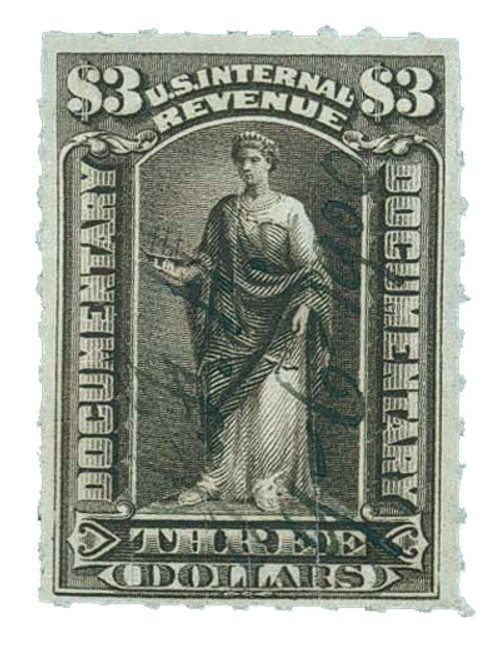
# R168 - 1898 10c US Internal Revenue Stamp -Battleship, dark brown
U.S. Revenue Stamps – Expand Your Collection or Start a New One
Intricate Revenue stamps feature the rich detail and historical importance of classic U.S. stamps for a fraction of the price. Acquiring a collection of these seldom-seen stamps is easy and affordable with Mystic as your collecting partner.
When the Civil War erupted in 1861, the country was on the verge of bankruptcy. A plan was developed to generate internal revenue – money collected from taxes placed on domestic items such as tobacco, alcohol, medicine, perfume and playing cards. Stamps were provided as proof of payment.
Examining used U.S. Revenue stamps offers a window into the past – the government required several unusual cancellation techniques such as private cancels, manuscript initials and perforated initials. The same legislation that created these stamps also created the Internal Revenue Service (IRS) and the Bureau of Engraving and Printing (BEP).
Until 1862, specific Revenue stamps were required for many taxable items – leading to a wealth of interesting stamps for modern collectors. Imperforate and “part-perf” error stamps present another challenging – yet affordable – collecting opportunity.
Birth Of Admiral George Dewey
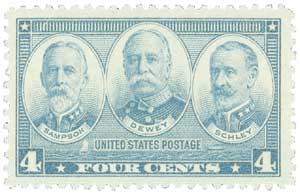
George Dewey was born in Montpelier, Vermont, on December 26, 1837. His father had helped found the National Life Insurance Company as well as the Christ Episcopal Church in Montpelier.
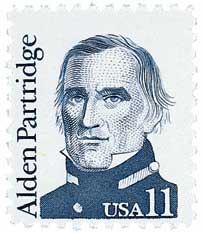
At 15, Dewey attended the Norwich Military School, also known as Norwich University. Dewey enjoyed his time there and adopted the legendary commander Hannibal as his role model after reading his biography.
In 1854, Dewey entered the Naval Academy where he was also an excellent student. Four years later he graduated fifth in his class. His first naval service was aboard the USS Saratoga, where he earned recognition as a cadet officer. After that, Dewey was transferred to the frigate USS Wabash. Aboard that ship, he traveled to the Mediterranean and was tasked with keeping the ship’s log.
When the Civil War broke out in 1861, Dewey was serving as an executive lieutenant aboard the USS Mississippi as part of the Union’s West Gulf Blockading Squadron. In early 1862, Dewey was part of Farragut’s fleet, which was assigned to capture New Orleans. On the night of April 24, Dewey’s ship was the third in the division to sail up the Mississippi River past Confederate defenses. He skillfully steered the ship through shallow water, despite fears that it might run aground. When the Confederate ironclad CSS Manassas tried to ram the Mississippi, Dewey evaded the attack. He then pursued the Manassas, running it aground before his men set it on fire.
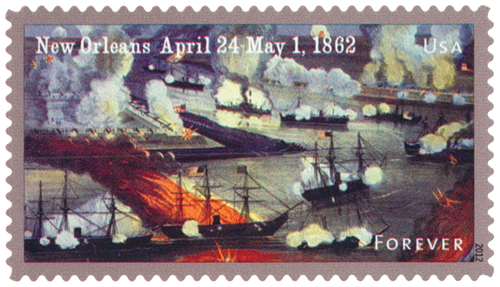
After the battle, Dewey remained in the area patrolling the river under fire from Confederate sharpshooters and occasional light artillery. The following March, Dewey was part of the battle to capture Port Hudson, Louisiana. It was the most intense fighting he would ever see, as his ship was run aground and fired upon by the enemy for half an hour.
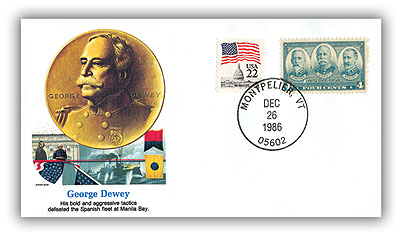
Forced to abandon the ship, Dewey was among the last to leave. He was then assigned to the Agawam. When the captain was wounded, he took temporary command and was awarded for his gallantry. He was then assigned to the USS Colorado, aboard which he helped attack Fort Fisher in 1865. During that action, Dewey helped to silence Confederate guns in just 15 minutes in what the New York Times called “the most beautiful duel of the war.”
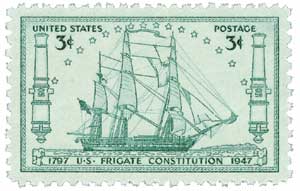
After the Civil War, Dewey traveled to Europe aboard the Kearsarge and later the Colorado. He was then given command of the ships at the Naval Academy in Annapolis. This included a brief command of the famed USS Constitution, which was then serving as a training ship. From there he went on to serve as an instructor at the Naval Academy and secretary of the lighthouse board, among other things. After a few years serving in Washington, DC, he was anxious to return to sea and was given command of the Asiatic Squadron, just before the start of the Spanish-American War.
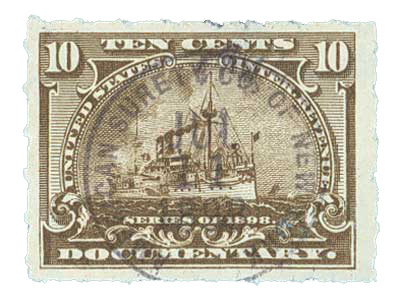
On April 26, 1898, Dewey was ordered to sail to the Philippines to engage the Spanish fleet. The Spanish leader believed that US ships would not attack until morning because Manila Bay could not be navigated safely at night. But Dewey had obtained detailed charts and confidently led his line of vessels through the narrow entrance during the night of April 30. When the sun rose the next morning, the Spanish fleet was surprised to be facing the enemy. At about 5:40 a.m., Dewey ordered: “You may fire when ready.” The American boats outgunned the Spanish vessels and coastal forts. By 12:30 that afternoon, the Spanish raised the white flag of surrender. Dewey was hailed as a hero and the Philippines came under American control, eventually becoming a US territory.
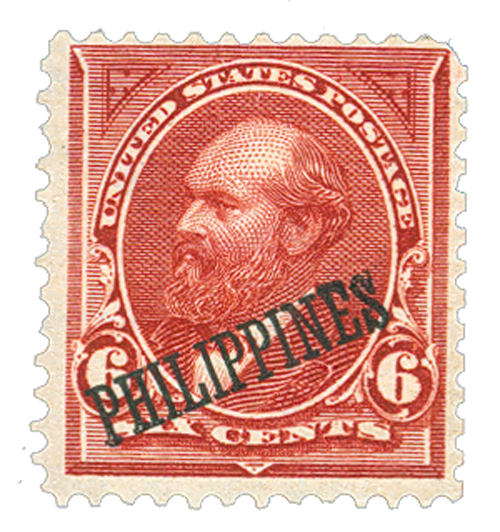
Dewey returned home a hero and was honored with a two-day parade in New York City. In 1903, he became the first and only American promoted to Admiral of the Navy (similar to General of the Army). After a brief attempt at running for president in 1900, Dewey was made the president of the General Board of the Navy Department, a position he held until his death on January 16, 1917.
U.S. Revenue Stamps – Expand Your Collection or Start a New One
Intricate Revenue stamps feature the rich detail and historical importance of classic U.S. stamps for a fraction of the price. Acquiring a collection of these seldom-seen stamps is easy and affordable with Mystic as your collecting partner.
When the Civil War erupted in 1861, the country was on the verge of bankruptcy. A plan was developed to generate internal revenue – money collected from taxes placed on domestic items such as tobacco, alcohol, medicine, perfume and playing cards. Stamps were provided as proof of payment.
Examining used U.S. Revenue stamps offers a window into the past – the government required several unusual cancellation techniques such as private cancels, manuscript initials and perforated initials. The same legislation that created these stamps also created the Internal Revenue Service (IRS) and the Bureau of Engraving and Printing (BEP).
Until 1862, specific Revenue stamps were required for many taxable items – leading to a wealth of interesting stamps for modern collectors. Imperforate and “part-perf” error stamps present another challenging – yet affordable – collecting opportunity.
Birth Of Admiral George Dewey

George Dewey was born in Montpelier, Vermont, on December 26, 1837. His father had helped found the National Life Insurance Company as well as the Christ Episcopal Church in Montpelier.

At 15, Dewey attended the Norwich Military School, also known as Norwich University. Dewey enjoyed his time there and adopted the legendary commander Hannibal as his role model after reading his biography.
In 1854, Dewey entered the Naval Academy where he was also an excellent student. Four years later he graduated fifth in his class. His first naval service was aboard the USS Saratoga, where he earned recognition as a cadet officer. After that, Dewey was transferred to the frigate USS Wabash. Aboard that ship, he traveled to the Mediterranean and was tasked with keeping the ship’s log.
When the Civil War broke out in 1861, Dewey was serving as an executive lieutenant aboard the USS Mississippi as part of the Union’s West Gulf Blockading Squadron. In early 1862, Dewey was part of Farragut’s fleet, which was assigned to capture New Orleans. On the night of April 24, Dewey’s ship was the third in the division to sail up the Mississippi River past Confederate defenses. He skillfully steered the ship through shallow water, despite fears that it might run aground. When the Confederate ironclad CSS Manassas tried to ram the Mississippi, Dewey evaded the attack. He then pursued the Manassas, running it aground before his men set it on fire.

After the battle, Dewey remained in the area patrolling the river under fire from Confederate sharpshooters and occasional light artillery. The following March, Dewey was part of the battle to capture Port Hudson, Louisiana. It was the most intense fighting he would ever see, as his ship was run aground and fired upon by the enemy for half an hour.

Forced to abandon the ship, Dewey was among the last to leave. He was then assigned to the Agawam. When the captain was wounded, he took temporary command and was awarded for his gallantry. He was then assigned to the USS Colorado, aboard which he helped attack Fort Fisher in 1865. During that action, Dewey helped to silence Confederate guns in just 15 minutes in what the New York Times called “the most beautiful duel of the war.”

After the Civil War, Dewey traveled to Europe aboard the Kearsarge and later the Colorado. He was then given command of the ships at the Naval Academy in Annapolis. This included a brief command of the famed USS Constitution, which was then serving as a training ship. From there he went on to serve as an instructor at the Naval Academy and secretary of the lighthouse board, among other things. After a few years serving in Washington, DC, he was anxious to return to sea and was given command of the Asiatic Squadron, just before the start of the Spanish-American War.

On April 26, 1898, Dewey was ordered to sail to the Philippines to engage the Spanish fleet. The Spanish leader believed that US ships would not attack until morning because Manila Bay could not be navigated safely at night. But Dewey had obtained detailed charts and confidently led his line of vessels through the narrow entrance during the night of April 30. When the sun rose the next morning, the Spanish fleet was surprised to be facing the enemy. At about 5:40 a.m., Dewey ordered: “You may fire when ready.” The American boats outgunned the Spanish vessels and coastal forts. By 12:30 that afternoon, the Spanish raised the white flag of surrender. Dewey was hailed as a hero and the Philippines came under American control, eventually becoming a US territory.

Dewey returned home a hero and was honored with a two-day parade in New York City. In 1903, he became the first and only American promoted to Admiral of the Navy (similar to General of the Army). After a brief attempt at running for president in 1900, Dewey was made the president of the General Board of the Navy Department, a position he held until his death on January 16, 1917.






